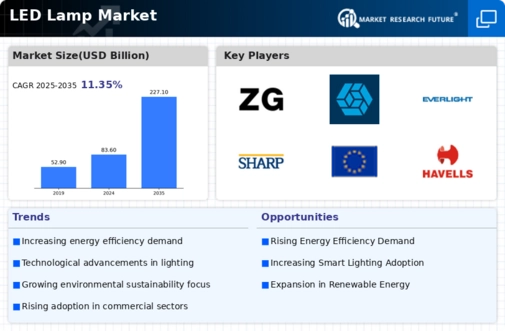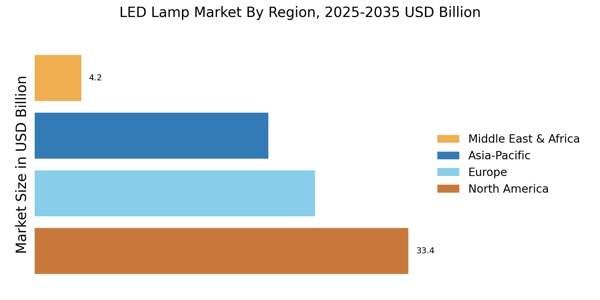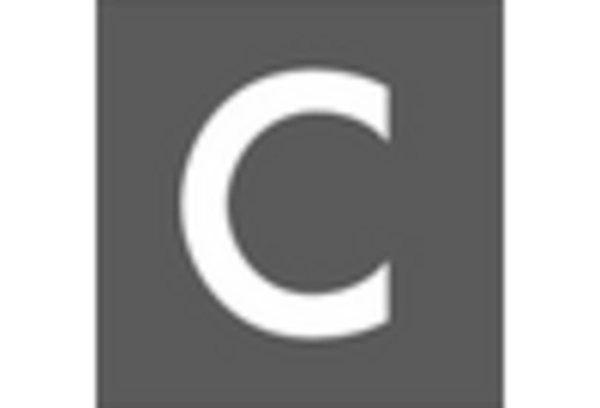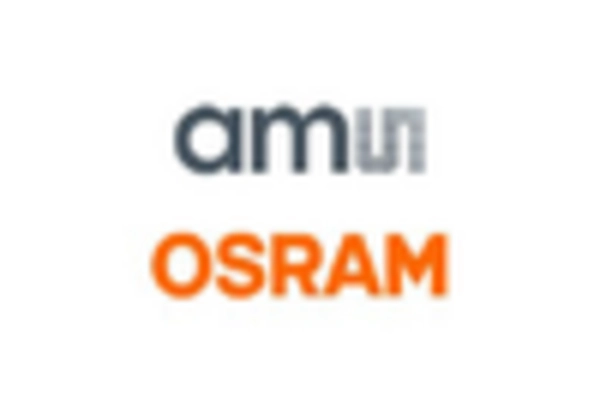Rising Urbanization
The trend of rising urbanization is contributing to the expansion of the LED Lamp Market. As urban areas continue to grow, the demand for efficient and effective lighting solutions is increasing. Urban environments require robust lighting systems that can cater to both residential and commercial needs. LED lamps, with their versatility and efficiency, are well-suited to meet these demands. Furthermore, urban planners are increasingly recognizing the importance of sustainable lighting solutions in city designs. This shift towards urbanization is likely to drive the adoption of LED technology, as municipalities seek to enhance public spaces while minimizing energy consumption. Consequently, the LED Lamp Market is expected to thrive in urban settings, where the need for innovative lighting solutions is paramount.
Energy Efficiency Demand
The LED Lamp Market is experiencing a surge in demand for energy-efficient lighting solutions. As energy costs continue to rise, consumers and businesses alike are increasingly seeking alternatives that reduce electricity consumption. LED lamps, known for their low energy usage and long lifespan, are becoming the preferred choice. According to recent data, LED lamps consume up to 75% less energy than traditional incandescent bulbs, which significantly lowers utility bills. This shift towards energy efficiency is not only driven by economic factors but also by a growing awareness of environmental sustainability. As regulations tighten around energy consumption, the LED Lamp Market is poised for substantial growth, as more entities transition to energy-efficient lighting solutions.
Technological Advancements
Technological innovations are playing a pivotal role in shaping the LED Lamp Market. The integration of smart technology into LED lighting systems is enhancing functionality and user experience. Features such as remote control, dimming capabilities, and compatibility with smart home systems are becoming increasingly prevalent. The market is witnessing a rise in demand for smart LED lamps, which are projected to account for a significant share of the overall market. Recent estimates suggest that the smart lighting segment could grow at a compound annual growth rate of over 20% in the coming years. This trend indicates that consumers are not only looking for energy efficiency but also for enhanced control and customization in their lighting solutions, further driving the LED Lamp Market.
Consumer Awareness and Preferences
Consumer awareness regarding the benefits of LED lighting is significantly shaping the LED Lamp Market. As individuals become more informed about energy efficiency, longevity, and environmental impact, their preferences are shifting towards LED solutions. Surveys indicate that a growing number of consumers prioritize energy-efficient products when making purchasing decisions. This heightened awareness is not only influencing residential markets but also extending to commercial sectors, where businesses are increasingly adopting LED technology to reduce operational costs. The trend suggests that as consumers continue to prioritize sustainability and cost-effectiveness, the LED Lamp Market will likely see sustained growth. This shift in consumer preferences is a critical driver, as it encourages manufacturers to innovate and expand their LED product offerings.
Government Initiatives and Regulations
Government initiatives aimed at promoting energy-efficient lighting are significantly influencing the LED Lamp Market. Various countries have implemented regulations to phase out incandescent bulbs and promote the adoption of LED technology. These policies often include incentives for consumers and businesses to switch to LED lighting, such as rebates and tax credits. For instance, some regions have set ambitious targets for reducing carbon emissions, which directly impacts lighting choices. As a result, the LED Lamp Market is likely to benefit from these regulatory frameworks, as they create a conducive environment for the adoption of LED technology. The ongoing support from governmental bodies is expected to bolster market growth and encourage innovation within the industry.

















Leave a Comment